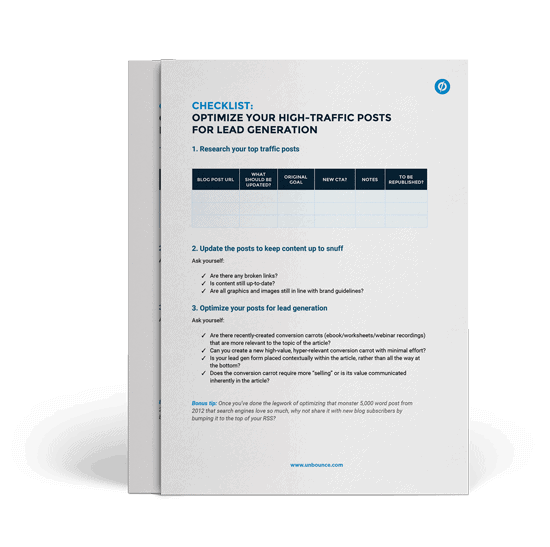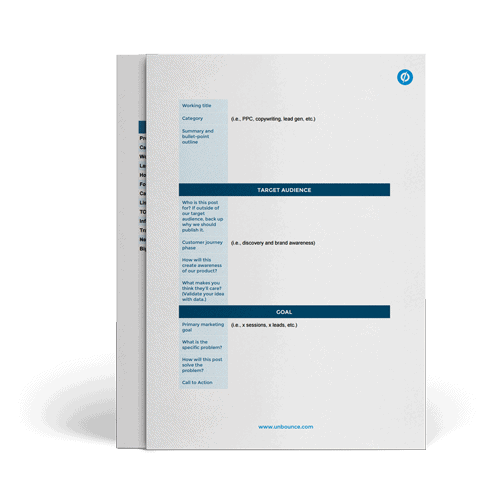Since I joined the Unbounce family three years ago, our marketing team has grown from seven to 35. The content team alone has grown from two to 12.
That kind of growth comes with a lot of potential to do exciting things.
But scaling a team quickly also uncovers inefficiencies, and results in a helluvalotta growing pains.
Which is fine, really. I’m not much of a jock, but I know that without pain there is no gain.

2016 in particular was a really productive year for the content team at Unbounce. We were able to fix a lot of inefficiencies in our processes, and experiment with things that we just didn’t have the bandwidth for before.
In short, we pulled the plug on what wasn’t working and doubled down on what was working.
If you’ll allow me to, I want to share some of our biggest takeaways with you. In part because I wanna show off our gains (#humblebrag), but also because I wanna prevent your pains.
(P.S. Much of this progress can be attributed to an improvement methodology we started using called the Improvement Kata, which could be the subject of its own 10,000-word post. …But you can learn all about it in this 60-minute webinar.)
Process improvements: If something is painful, it’s because it’s broken
When I began work at Unbounce in 2014, I was the main person dedicated to the blog. I spent my days writing, editing and making sure that we maintained our historically high editorial standards.
But I was doing this in a silo, so when we began onboarding more team members who were to contribute to the blog, things started to feel a little painful.
Suddenly, it was evident that we needed new processes. And the only way to fix inefficiencies was to first diagnose them:
- I was spending too much of my time working with external contributors and responding to queries that I couldn’t focus on content that contributed to big picture business objectives
- I was used to being a lone wolf, but now my team members needed visibility into which posts were in the pipeline (and at what stage)
- With more team members, prioritization of content pieces was becoming more difficult
After listing all the pains, we started looking for solutions as a team.
What did the doctor(s) order? You can read about all our process improvements in this post, but here are some of my personal favorites:
- We killed our “Write For Us” page.
- We refused to take on any post that didn’t first have a fully fleshed-out pitch (you can steal the template for it below).

Ready to optimize your high-traffic posts for lead gen?
But my favorite change was one that alleviated a ton of pain…
Treat blog posts like campaigns
When I started blogging in 2008, the #1 piece of advice I was given was to establish a posting frequency and then stick to it.
But last year, at marketing conferences and across the web, I began to hear whispers of something different: publish less, but publish deeper.
This suggestion was attractive to me because I’d been working hard for two years to make sure that our editorial calendar was filled with back-to-back actionable articles. I was able to maintain a frequent publishing schedule, but this resulted in me neglecting something far more important: a sound distribution strategy.
We were working hard to create awesome content, but weren’t making the time to be sure that people would take notice.
So in 2016, we started experimenting with treating blog posts like campaigns.
What do I mean by this? Taking the time to plan, write and promote epic posts — the kind of stuff that makes your CMO drop their work and share the post in a department-wide email — even if it means dialing back on publishing frequency.
More specifically, “campaign” posts go through five phases (read about them in detail in this post):
- Determine the goal of your post so you can determine later whether or not it was successful (and guide the content of the post).
- Do keyword research if appropriate so your post will continue to get organic traffic.
- Loop in influencers who can help you amplify your content after you hit publish. Include quotes — as Andy Crestodina said in his keynote at Content Marketing World, “An ally in content production is an ally in content distribution.” Beyond that, start thinking about distribution strategy before you write a single word.
- Create custom blog assets that you’d like to see in your own social media feeds. Think of how you can create a consistent design experience across all channels.
- Distribute according to a predetermined plan. Milk all your channels for everything they’re worth.
We get so much more out of posts when we take this well-rounded approach — we feel happier and more strategic (instead of feeling like we’re on a content farm). It feels less painful and it actually feels like less work. Here’s another great bit I heard at Content Marketing World:
Don't take shortcuts, they take too long. @soniasimone #CMWorld #contentmarketing pic.twitter.com/D096JIjC5Z
— The Narrative, LLC (@TheNarrativeLLC) September 7, 2016
More of a spirit of experimentation
Optimization is such a core part of our business — we preach it in our webinars, on our podcast, on the blog. “Always be testing” echoes through the hallways to the extent that it’s become a bit of a cliché.
Yet, when it came to actually conducting tests on our blog and other content, we were quicker to make excuses than make time for optimization. Not because we were slackers — quite the opposite — but because we were too focused on furiously pumping out content to take a step back and take a look at the bigger picture.
Until we decided to just do it ✔️️ and were inspired to launch a two week optimization experiment. For the experiment, we halted publishing and focused entirely on optimizing evergreen content. In a nutshell we:
- Researched top traffic posts
- Freshened up the content of the post to keep them evergreen
- Optimized those posts for lead generation (this part was key)
You can read all about our experiment (and how it resulted in 700 new leads for us) in this post. Or just grab the checklist below and get started.

Produce better content by getting off on the right foot
Our main takeaway? Optimization isn’t just for conversion rate optimizers and performance marketers. Content marketers stand to gain a lot by taking a step back, too. Even if it means temporarily forgetting about your editorial calendar.
More accountability
Everyone is aware of certain inefficiencies and pains within their organization or on their team, but seldom do we make the time to take ownership of these and actually resolve to fix them.
I’d encourage you to take a step back and think about what hurts and what bandaids you have at your disposal. It may seem daunting or like a lot of work at first, but I think you’ll find that it pays off in the long run.
